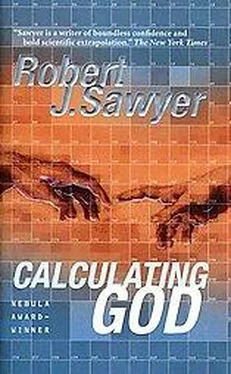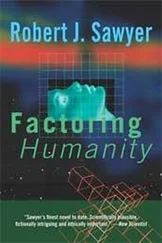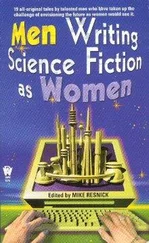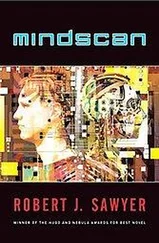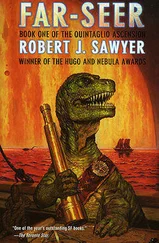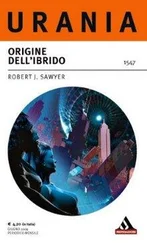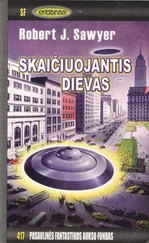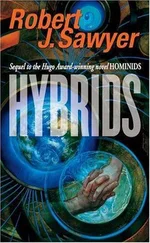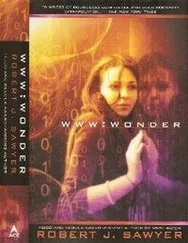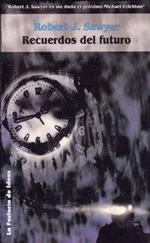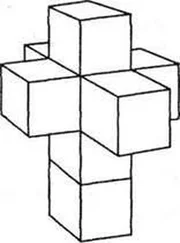Robert Sawyer - Calculating God
Здесь есть возможность читать онлайн «Robert Sawyer - Calculating God» весь текст электронной книги совершенно бесплатно (целиком полную версию без сокращений). В некоторых случаях можно слушать аудио, скачать через торрент в формате fb2 и присутствует краткое содержание. Город: New York, Год выпуска: 2000, Издательство: Tor Books, Жанр: Фантастика и фэнтези, на английском языке. Описание произведения, (предисловие) а так же отзывы посетителей доступны на портале библиотеки ЛибКат.
- Название:Calculating God
- Автор:
- Издательство:Tor Books
- Жанр:
- Год:2000
- Город:New York
- ISBN:нет данных
- Рейтинг книги:5 / 5. Голосов: 1
-
Избранное:Добавить в избранное
- Отзывы:
-
Ваша оценка:
- 100
- 1
- 2
- 3
- 4
- 5
Calculating God: краткое содержание, описание и аннотация
Предлагаем к чтению аннотацию, описание, краткое содержание или предисловие (зависит от того, что написал сам автор книги «Calculating God»). Если вы не нашли необходимую информацию о книге — напишите в комментариях, мы постараемся отыскать её.
Calculating God — читать онлайн бесплатно полную книгу (весь текст) целиком
Ниже представлен текст книги, разбитый по страницам. Система сохранения места последней прочитанной страницы, позволяет с удобством читать онлайн бесплатно книгу «Calculating God», без необходимости каждый раз заново искать на чём Вы остановились. Поставьте закладку, и сможете в любой момент перейти на страницу, на которой закончили чтение.
Интервал:
Закладка:
The entity continued to eclipse Betelgeuse — or whatever was left of it — until we were quite close to it. Then it rolled aside, its six limbs moving like the spokes of a wheel, revealing the vast pink nebula that had formed behind it and the tiny pulsar, the corpse of Betelgeuse, at its heart.
But that was its only acknowledgement of our presence, at least as far as I could tell. I wished again for real windows: maybe if it could see us waving at it, it would respond in kind, moving one of its vast obsidian pseudopods in a slow, majestic arc.
It was maddening: here I was, within spitting distance of what might well be God, and it seemed as indifferent to me as, well, as it had been when tumors had started to form in my lungs. I’d tried once before to speak to God and had received no reply, but now, dammitall, surely courtesy if nothing else required a response; we had traveled farther than any human or Forhilnor or Wreed ever had before.
But the entity made no attempt at communication — or, at least, none that I, or Zhu, my ancient Chinese fellow traveler, or Qaiser, the schizophrenic woman, or even Huhn, the silverback gorilla, could detect. Nor did the Forhilnors seem to be able to contact it.
But the Wreeds —
The Wreeds, with their radically different minds, their different way of seeing, of thinking —
And with their unshakeable faith . . .
The Wreeds apparently were in telepathic communication with the being. After years of trying to talk to God, God was now, it seemed, talking to them, in ways only they could detect. The Wreeds could not articulate what they were being told, just as they couldn’t articulate in any comprehensible way the insights about the meaning of life that gave them peace, but nonetheless they started building something in the Wreed centrifuge.
Before it was finished, Lablok, the Merelcas’s Forhilnor doctor, recognized what it was, based on its general design principles: a large artificial womb.
The Wreeds took genetic samples from the oldest member of their contingent, a female named K’t’ben, and from the oldest Forhilnor, an engineer named Geedas, and —
No, not from me, although I wished it had been; it would have brought completion, closure.
No, the human sample they took was from Zhu, the ancient Chinese rice farmer.
There are forty-six human chromosomes.
There are thirty-two Forhilnor chromosomes.
There are fifty-four Wreed chromosomes . . . not that they know that.
The Wreeds took a Forhilnor cell and vacuumed all the DNA from the nucleus. They then carefully inserted into that cell diploid sets of chromosomes from Geedas and K’t’ben and Zhu, chromosomes that had divided so many times already that their telomeres had been reduced to nothing. And this cell, containing the 132 chromosomes from the three different races, was carefully placed into the artificial womb, where it floated in a vat of liquid containing purine and pyrimidine bases.
And then something astonishing happened — something that caused my heart to jump, that caused Hollus’s eyestalks to move to their maximum separation. There was a flash of bright light; the Merelcas’s sensors revealed that a particle beam had shot out of the precise center of the black entity, passing right through to the artificial womb.
Peering in with a magnifying scanner, the interactions were astonishing.
Chromosomes from the three worlds seemed to seek each other out, joining up into longer strands. Some consisted of two Forhilnor chromosomes joined together, with a Wreed chromosome at the end; Hollus had talked about the Forhilnor equivalent of Down syndrome and of how telomere-lacking chromosomes could join end to end, an innate ability, seemingly useless, even detrimental, but now . . .
Other chains consisted of human chromosomes sandwiched between Forhilnor and Wreed chromosomes. Still others consisted of human chromosomes at either end of a Wreed. A few chains were only two chromosomes long; usually a human and a Forhilnor. And six of the Wreed chromosomes remained unaltered.
It was obvious now that strands of DNA had built into them the ability to do more — much more — than simply die or form tumors after their telomeres had been eliminated. Indeed, telomere-less chromosomes were ready for the long-awaited next step. And now that intelligent lifeforms from multiple worlds had finally, with a little prodding, come into existence simultaneously, these chromosomes were at last able to take that step.
I now understood why cancer existed — why God needed cells that could continue to divide even after their telomeres were exhausted. The tumors in isolated lifeforms were merely an unfortunate side effect; as T’kna had said, “The specific deployment of reality that included cancer, presumably undesirable, must have also contained something much desired.” And the much-desired thing was this: the ability to link chromosomes, to join species, to concatenate lifeforms — the biochemical potential to create something new, something more.
I dubbed the combined chromosomes supersomes.
And they did what regular chromosomes do: they reproduced, unzipping down their entire length, separating into two parts, adding in corresponding bases from the nutrient soup — a cytosine pairing with every guanine; a thymine for every adenine — to fill in their now-missing halves.
Something fascinating happened the first time the supersomes reproduced: the strand got shorter. Large sequences of intronic DNA — junk — dropped out during the copying process. Although the supersomes contained three times as much active DNA as did regular chromosomes, the resulting strings were much more compact. The supersomes did not push the theoretical limit of the size for biological cells; indeed, they packed even more information into a smaller space.
And, of course, when the supersomes reproduced, the cell containing them divided, creating two daughter cells.
And then those cells divided.
And on and on.
Prior to the middle of the Cambrian, life had had a fundamental constraint imposed by the fact that fertilized cells could not divide more than ten times, severely limiting the complexity of the resulting organism.
Then the Cambrian explosion occurred, and life suddenly got more sophisticated.
But there were still limits. A fetus could grow only so large — baby humans and Wreeds and Forhilnors all massed on the order of five kilograms. Larger babies would have required impossibly wide birth canals; yes, bigger bodies could have accommodated bigger brains via live birth — but much of the additional brain mass would end up being devoted to controlling the larger body. Maybe, just maybe, a whale was as intelligent as a human — but it wasn’t more intelligent. Life had apparently reached its ultimate level of complexity.
But the supersome-driven fetus continued to grow larger and larger in its artificial womb. We had expected it to stop on its own at some point: oh, a Forhilnor might stumble into life with a double-length chromosome; a human child might survive for a time having three chromosome twenty-ones. But this combination, this wild genetic concoction, this mishmash, was surely too much, surely pushed the limits of the possible too far. Most pregnancies — be they Wreed or Forhilnor or human — spontaneously abort early on as something goes wrong in the embryo’s development, usually before the mother is even aware that she’s pregnant.
But our fetus, our impossible triple hybrid, did not.
In all three species, ontogeny — the development of the fetus — seems to recapitulate phylogeny — the evolutionary history of that organism. Human embryos develop then discard gills, tails, and other apparent echoes of their evolutionary past.
Читать дальшеИнтервал:
Закладка:
Похожие книги на «Calculating God»
Представляем Вашему вниманию похожие книги на «Calculating God» списком для выбора. Мы отобрали схожую по названию и смыслу литературу в надежде предоставить читателям больше вариантов отыскать новые, интересные, ещё непрочитанные произведения.
Обсуждение, отзывы о книге «Calculating God» и просто собственные мнения читателей. Оставьте ваши комментарии, напишите, что Вы думаете о произведении, его смысле или главных героях. Укажите что конкретно понравилось, а что нет, и почему Вы так считаете.
